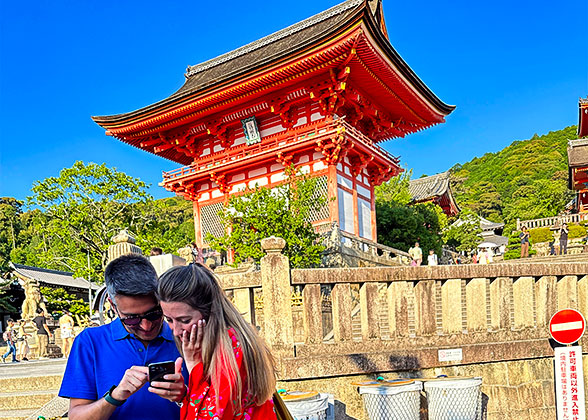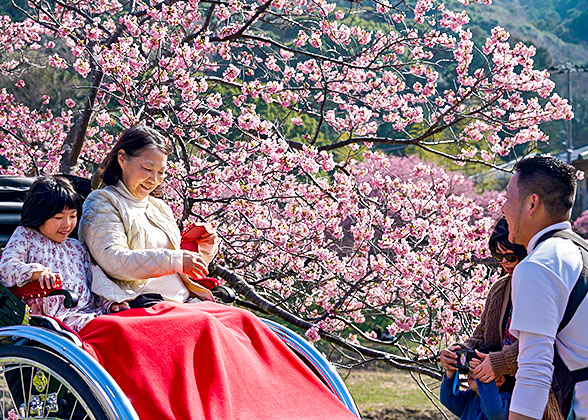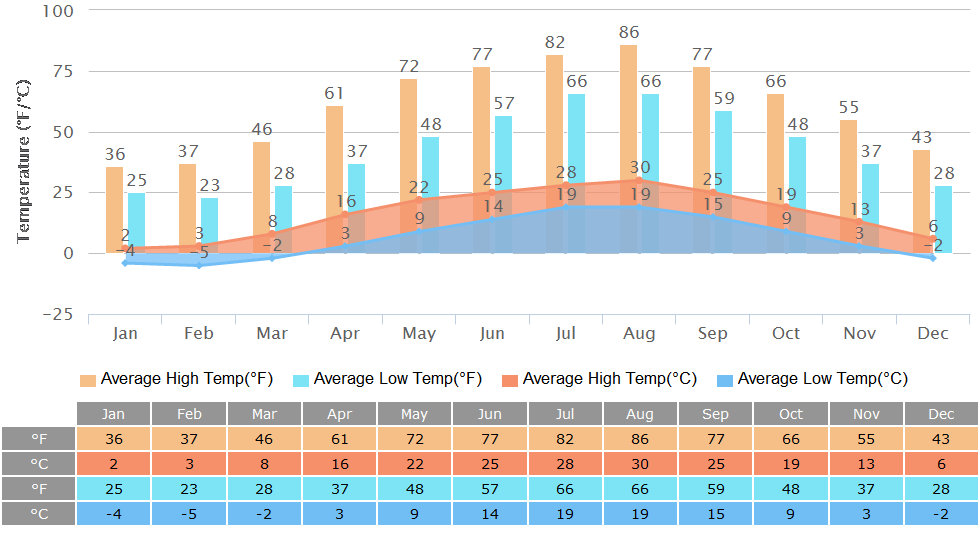Shirakawa-go Weather
Shirakawa-go experiences a humid continental climate with four distinct seasons: springs from April to May are warming up; summers from June to August have not very hot but rainy weather. Freezing winters, from December to March, bring surprisingly abundant snowfall, making it one of the most popular regions to see winter scenery. In cool autumns, unique farmhouses and mountains capped in colorful leaves create breathtaking natural views.Temperature
Surrounded by mountains, Shirakawa-go has two climatic features in terms of temperature. Firstly, the temperature range over the year is wide: in August, the hottest period, temperatures can reach 35 degrees Celsius (95 degrees Fahrenheit) or above; in January, the coldest month, the temperature often declines below freezing and even sometimes down to -9℃ (15.8℉). Secondly, the area is characterized by a huge temperature difference between day and night. Take winter as an example: it is bitterly cold at night, but you may feel fresh at midday on sunny days.
Precipitation
Located in the windward slope of the mountain area, total precipitation of Shirakawa-go is abundant all year around, with a yearly average of 2,665 - 2,920mm (105 - 115 in).Rainfall
June and July are traditionally regarded as the rainy season in Shirakawa-go, but August and September also receive high rainfall. During these four months, light showers frequently occur, and it’s highly likely to rain every day for one week or longer.Snowfall
Shirakawa-go is one of places with the heaviest snowfall in Japan, making it a winter wonderland with stunning snowy scenery and various winter events. The area typically experiences snowfall from December and March each year, and the depth of accumulated snow often exceeds 1 - 2 meters (39 - 79 in).
Humidity Graph of Shirakawa-go
Best Time to Visit Shirakawa-go

Gassho-style Houses in Winter
|
Shirakawa-go has been a world-renowned destination to admire snowy landscapes. During January and February, its gassho-style houses, whose roof looks like praying hands, are carpeted with deep snow, and their beauty becomes more striking against the backdrop of white mountains. Meanwhile, don’t miss light-up events at night: bathed in beautiful light, the village draws you into a dreamlike fairy world.
Leaves change color in mid-October, reaching its colorful prime between late October and middle November. Over the whole mountain, red and golden leaves spread out, eventually forming a colorful tapestry. Besides, the three most known Doburoku festivals in Shirakawa-go are successively held during the second part of October, when you have a chance to taste Nigori (a kind of unstrained sake).
Middle April to early May is also a nice period for travel, when the weather is comfortable and cherry blossoms are in full bloom.
See more about Best Time to Visit Japan & Japan Weather
Shirakawa-go Weather by Month
Shirakawa-go Climate - Seasons, Clothes, and Travel Advice
Winter from December to March: Snowy Kingdom
Weather: Shirakawa-go has a cold climate in winter, especially in January and February with the lows of -5 - 0℃ (23 - 32℉). What’s more, it experiences frequent snowfall, and you might see the first snow in early December. The snowfall is the greatest in January and February, contributing to the most breathtaking scenery. Snowy days usually bring fog, causing poor visibility. Occasional high winds make your apparent temperature lower.Dressing guidelines: Given indoor places with sufficient heating, onion-like dressing is advised. Sweaters or hoodies are proper as inner clothes, paired with down jackets or woolen overcoats. Choose snow pants and comfortable anti-slip snow boots, which are better to be waterproof. Winter hats, gloves and facial masks are necessary to keep warm, and remember to pack raingear.
Top things to do:
1. Ogimachi Castle Observation Deck and Shiroyama Tenshukaku Observation Deck are the best places to see a panoramic view of snow-covered Shirakawa-go. During four lighting nights from middle January to early February, the area nearby Wada House is a pretty site for photography.
2. Enjoying an onsen bath at Shirakawa-go no Yu Hotel helps your body warm up.
3. Nothing beats a steaming-hot bowl of soba (buckwheat noodles) topped with wild vegetables on a cold winter day.

Snowy View from Observatory
|
Spring from April to May: Cherry Blossom Heaven
Weather: As spring comes, it gets warmer and warmer in Shirakawa-go, averaging roughly 3 - 16℃ (37.4 - 60.8℉) in April, and 9 - 22℃ (48.2 - 71.6℉) in May. The temperature difference within a day is well in excess of 10℃ (57℉). Plus, significant temperature drops and rises might occur in just a few days. For instance, the high rose by 14℃ (57℉) in April 13 - 19, 2025. Rainfall is the lowest over the whole year.Outfits: In April, hoodies, thin sweaters, lightweight down jackets and thick sweatpants are highly recommended. By May, pack long-sleeved shirts, cardigans and regular sweatpants. Choose casual shoes with soft insoles, relieving foot pain after a long walk. You’d better prepare a vest to cope with temperature changes, and wear a facial mask if allergic to pollen.
Best things to do:
1. As mentioned above, Middle April to early May is the best time to admire Sakura in Shirakawa-go. Here are two recommended sites: one is Gasshozukuri Minkaen Outdoor Museum- in middle April, the reflection of cherry flowers in the pool attracts lots of shutterbugs; the other is Shirakawa-go Honkaku-ji Temple- it is well-known for extremely large and magnificent cherry blossoms of one cherry tree in early May.
2. Shirakawa-go hosts Rice Planting Festival every late May, when more than a dozen females are dressed up as ancient peasant girls, line up in a field and sing local folk songs while transplanting rice.

Visitors Seeing Cherry Flowers
|
Summer from June to August: Lush Wonderland
Weather: In hot and humid summer, maximum temperatures are often 25 - 35 ℃ (77 - 95℉) while the minimum are 15℃ (59℉) or above. The rainfall sharply increases, reaching its annual peak in July totaling 357mm (14 in) averagely. Although it rains frequently, sunny days have strong sunshine, particularly at noon and in early afternoon.What to wear: It’s better to bring breathable and loose short-sleeved T-shirts and shorts or skirts, paired with comfy walking shoes. Sun-protective clothing is very useful to protect against intense UV rays and give you warmth in cooler mornings and evenings. Besides, sunglasses, hats, sunblock and rain gear are the musts in summer. The paths get wet and slippery on rainy days, so pack shoe covers.
Travel suggestions:
1. The highlight of Shirakawa-go in summer is vibrant natural landscapes. Especially in July, the front of the houses is studded with blooming pink and purple hydrangeas and the village is surrounded by green rice paddies, showing a picturesque scene.
2. There are many mosquitoes, so mosquito repellent is essential.
|
|
|
Autumn from September to November: Colorful Fairyland
Weather: The temperature in autumn steadily goes down in Shirakawa-go. Though September marks the onset of the autumn, it is still warm with the average temperature of 15 - 25℃ (59 - 77℉); by November, it drops to roughly 3 - 13℃ (37.4 - 55.4℉), and night temperatures hovers around freezing at the end of the month. The day-night temperature gap usually exceeds 10℃ (50℉). In total, the precipitation is relatively high, with an average of 13 rainy days per month.Clothes to wear: Short sleeved T-shirts, thin sweatpants and non-slip walking shoes are suitable outfits in September; wear long-sleeved shirts, hoodies or thin sweaters, jeans and comfy sneakers in October and November. Bring along a trench coat if you plan to go outside in the early morning and evening. Umbrellas, raincoats and waterproof shoe covers are necessities.
Seasonal highlights:
1. Wandering around Shirakawa Hachiman Shrine and Myozenji Temple, you can enjoy colorful fall leaves up close; standing on the Deai Bridge, sparkling Shō River, colorful trees and thatched-roof houses all come into view.
2. There is a wealth of activities during Doburoku Festival on October 14 - 19, including a procession where an ornate shrine is paraded from the village, lion dances and performances of traditional folk songs and dances.

The Shoromon Gate
|
You May Like
-
 8 Days Mini Group Tour to Tokyo - Hakone & Mt. Fuji - Kyoto - Nara - Osaka - Hiroshima - Osaka from USD2771
8 Days Mini Group Tour to Tokyo - Hakone & Mt. Fuji - Kyoto - Nara - Osaka - Hiroshima - Osaka from USD2771 -
 11 Days Mini Group Tour to Tokyo - Hakone (Mt. Fuji) - Kyoto - Nara - Osaka - Hiroshima - Kanazawa - Shirakawa-go ... from USD3554
11 Days Mini Group Tour to Tokyo - Hakone (Mt. Fuji) - Kyoto - Nara - Osaka - Hiroshima - Kanazawa - Shirakawa-go ... from USD3554 -
 13 Days Private Tour of Tokyo - Kamakura - Tokyo - Mt. Fuji - Kyoto - Nara - Hiroshima - Osaka from USD4390
13 Days Private Tour of Tokyo - Kamakura - Tokyo - Mt. Fuji - Kyoto - Nara - Hiroshima - Osaka from USD4390



